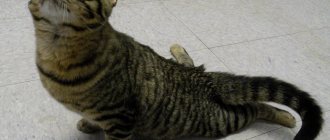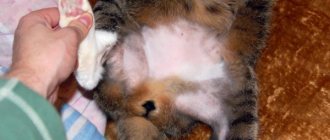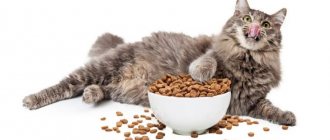When a pet's health fails, owners do not always show concern when trying to treat the animal at home. If your cat's hind legs begin to fail, this is a reason to immediately contact a veterinarian.
The reason for limb failure may be a serious illness or injury that requires immediate treatment. Slowness can be fatal. Any gait disturbances, paralysis, or spinal injuries in an animal cannot be cured on your own.
Failure to contact a veterinarian in a timely manner greatly increases the risk of complete loss of sensitivity and mobility of the paws.
So, the cat’s hind legs are failing, causes, signs, treatment, prognosis.
Failure of a cat's hind legs: causes of a dangerous condition
Impaired mobility of an animal's limbs can be caused by various reasons. It is very difficult for the owner to independently understand what caused the paralysis, so in this case it will not be possible to do without a trip to the veterinarian.
Failure of a cat's hind legs can be caused by:
- Spinal injuries. Limbs often lose mobility as a result of spinal column injuries. Trauma to the lumbar region especially often leads to such consequences. Animals with access to the outdoors are susceptible to similar injuries. They may be run over by a vehicle or fall from a height or jump awkwardly from a tree. Apartment pets also get injured when jumping from a closet or windowsill. Problems with the limbs are indicated by immobility of the hind legs, tail and general weakness.
- Thrombosis of the femoral arteries. Thromboembolism of the femoral arteries leads to loss of sensation in the limbs, which develops gradually. During its development, the animal experiences severe pain in the lower back, screams and behaves restlessly. If you do not show your pet to a doctor in a timely manner, tissue necrosis will begin and it will be impossible to restore the mobility of the hind legs. In addition, after a few days, thrombosis will lead to death.
- Tick bite. Tick bites, although rare, cause paralysis, leading to the death of the animal. After a tick bite, the animal becomes agitated, followed by weakness, apathy, trembling and paralysis. If action is not taken in time, death occurs.
- Inflammation of the spinal fluid. Myelitis develops against the background of infectious diseases, helminthic infestations, injuries and poisoning. The pathology is characterized by failure of the cat's hind legs, chaotic movements, elevated temperatures, upset stomach, diarrhea and urinary incontinence. Timely treatment will lead to relief of the disease and complete restoration of the mobility of the pet’s limbs.
- Hip dysplasia. With this pathology, bone formation is disrupted. The disease primarily affects large breed cats. The disease leads to the development of severe pain when walking and jumping. If the owner does not provide supportive treatment, this will lead to limb failure.
- Stroke. A cat's hind legs may also fail due to a stroke. The disease can affect both older and young animals as a result of poor nutrition or a sedentary lifestyle. When the cerebral vessels are blocked, paralysis of the limbs develops. Timely treatment, which should begin immediately after diagnosis, will help eliminate it.
- Heart failure. If the cardiovascular system does not work properly, the animal's limbs may fail. This occurs due to oxygen starvation, against the background of which muscle tissue atrophy develops. In addition, heart problems manifest themselves in shortness of breath, dry cough and lethargy.
Other pathologies also lead to loss of limb mobility, which can only be identified by a specialist after a complete examination of the sick cat.
Diagnosis and treatment of illness
In a veterinary clinic, a doctor examines a patient: palpates muscles and joints, determines sensitivity to touch, and checks reflexes. Then X-ray examinations are prescribed - the image can show the presence of fractures, dislocations, neoplasms (tumors), and joint deformities.
One type of radiography is myelography. The procedure is performed to examine the spine using contrast fluid. The test helps determine the presence of a spinal cord tumor or herniated disc. Computer or magnetic resonance imaging (CT or MRI) is considered more detailed, but also more expensive.
If the veterinarian suspects infection, inflammatory processes, or metabolic disorders, he will prescribe blood and urine tests, as well as bacterial cultures.
Once the diagnosis is made, treatment begins. It depends entirely on the disease, the symptom of which is paw failure.
Conservative methods
For diseases of the joints and cartilage, anti-inflammatory and painkillers and therapeutic physiotherapy are prescribed. Blood clots are eliminated with anticoagulants and fibrinolytic medications, but if they do not work immediately, surgery is performed.
Hip dysplasia is treated with analgesics, chondroprotectors or physiotherapy. In severe cases, surgery will have to be performed.
A course of antibiotics and supportive medications are prescribed for inflammation of the spinal cord. Vitamin deficiency and nutritional hyperparathyroidism are eliminated by adjusting the diet and using vitamin-mineral complexes. The diet is prescribed by a veterinarian, who also monitors the patient until complete recovery.
You can cope with the consequences of an encephalitis tick bite with a course of antibiotics, diuretics (diuretics), nootropic and anticonvulsants. They try to restore the affected areas of the brain with the help of neurotransmitters, antispasmodics, and restorative medications.
All medications must be used strictly in accordance with the instructions prescribed by the veterinarian! Any deviation from the prescription is fraught with complication of the condition of the mustachioed patient.
When is surgery indicated?
Basically, spinal injuries are treated with surgery, the same is suitable for removing hernias - this reduces the load on the intervertebral discs. In rare cases, conservative treatment is required. Limb injuries require surgery only in case of severe displacement or spread of fragments.
If the cause of immobility is tumors of various types, then radiation, medications and surgical intervention can help the animal.
Thromboembolism requires a quick response. If medications do not help within 6-8 hours after the blockage of the vessel, veterinarians perform surgery to remove the blood clot.
Physiotherapy
For some animals, paw mobility does not return or partially returns even after the root cause of paralysis is eliminated. Then the owner needs to apply physiotherapeutic methods - this will restore sensitivity to the paws and tone to the muscles.
Physiotherapy can be carried out in parallel with drug therapy, but first you need to coordinate this with a veterinarian so as not to harm the pet and not cause discomfort, pain, or stress.
What exercises are good:
- stroking and tickling paw pads - from 2 to 6 times a day;
- “bicycle” - carefully reproduce the pedaling of the cat’s paws;
- imitation of walking - for this, a ball or a wide strip of fabric (towel) is placed under the cat’s belly, by which the person holds the pet; The cat must thus remember the walking mechanism and try to repeat it.
Physiotherapy may also include a special massage that your veterinarian will demonstrate to you. The key to this type of treatment is patience, as results may take several weeks or even months to appear.
Symptoms characteristic of limb failure
Paresis of the limbs is represented by the following symptoms:
- complete or partial impairment of motor functions. The animal stops moving quickly, drags its paws or moves crawling;
- change in gait. If swaying and pulling up of the limbs is normal for a small kitten, then failure of the cat’s hind legs requires immediate intervention by a veterinarian;
- atrophy of the muscular system. The muscles of the hind limbs lose their elasticity;
- soreness when feeling the hind legs. The cat screams and struggles when the back of the body is probed;
- lack of sensitivity. The animal stops feeling cold and warmth with its paw pads.
If such symptoms appear, your pet should be taken to a veterinarian immediately.
Consequences and forecasts
If you go to the veterinary clinic in time, the percentage of a positive outcome will be very high. Regardless of what caused the paralysis or paresis, quick, qualified help will get your pet back on its feet – literally. If you start the disease, the consequences will be disastrous.
Troubles with the spine will result in complete or partial paralysis of the body, inability to move or even control the processes of bowel and bladder emptying. Such animals need constant care and increased attention. Recovery will be long and not always 100%, but we must not despair.
Viruses and bacterial infections of an aggressive form can kill an animal in a few days. Some diseases (for example, rabies) cannot be treated at all.
Problems with the functioning of internal organs and the endocrine system are quite treatable, but the pet automatically falls into the group of vulnerable animals. Many of them need a lifelong diet and regular medical supervision.
Arthritis, arthrosis and dysplasia cause severe pain to the cat. They cannot be cured, but the process of cartilage destruction can be significantly slowed down. The owner needs to regularly treat his pet and take him to the veterinarian more often. During exacerbations, the cat may stop walking and experience severe pain.
Sad consequences can only be prevented by timely treatment, or better yet, prevention.
First aid
If the owner notices a failure of the cat’s hind legs or problems with mobility, then before taking it to the veterinarian, he must provide first aid to the animal.
First you need to calm the pet and put it in a carrier or house. Then, if the hind paws are cold, you need to warm them up with a heating pad. After this, you need to immediately go to the veterinary clinic.
What does it look like
Failure of the hind limbs is easy to notice, but there are cases when the animal prefers to lie down for several days and refuse to eat or drink. As a rule, the cat still gets up to go to the toilet. At this point, changes in gait can be seen. In the early stages, disorders may look like this:
- an unsteady gait that looks like you've lost your balance;
- severe wobbling of the back of the body;
- the hind legs move apart;
- after a few steps the cat sits down, doing this many times until the path is completed;
- the animal drags its legs along the floor without lifting them off the ground.
Worsening usually occurs very quickly, but if the owner manages to contact a veterinary clinic at an early stage, then treatment will have a greater chance of success.
How to treat paresis of the lower extremities?
After delivering the cat to the veterinarian, the specialist conducts an examination, determines the degree of sensitivity of the hind limbs, takes an X-ray and ultrasound, and also takes the tailed patient’s blood and urine for analysis.
Therapy is prescribed only after an accurate diagnosis has been made. It includes medication, physiotherapy, massage, and sometimes surgery.
Carrying out diagnostics
Since immobility or impaired movement of limbs and organ functioning can be caused by various reasons, diagnosis is carried out comprehensively. The animal undergoes x-rays in the frontal and other planes, ultrasound of internal organs, MRI of the brain and spinal column; if a stroke or other vascular and cardiac problems are suspected, Doppler sonography may be required.
Determining the cause and treating paralysis requires performing a general and biochemical blood test, conducting a bacteriological examination, and taking a urine sample.
In addition to conducting such studies and tests, the doctor will definitely take care of paralyzed limbs. He will check whether the animal feels touch, whether it is in pain, and will test for neurological and tendon reflexes. The collected data will allow you to get a picture of how sick the cat is and how treatment should be carried out.
Drug treatment
If paresis of the limbs is confirmed, appropriate drug therapy is selected for the cat. Depending on the disease that caused the paralysis, various drugs are used. They can be presented:
- antibiotics to relieve inflammation caused by infection;
- vitamins to strengthen the immune system;
- drugs that thin the blood for thrombosis and stroke;
- anti-mite drugs;
- diuretics.
The treatment regimen may differ depending on the underlying disease that caused the failure of the cat's hind legs.
Types of feline paralysis
If paralysis is detected in a cat, it can manifest itself in several forms:
- paraplegia - paralysis of the hind legs, which often occurs with stroke, spinal injury, inflammation of the spinal cord, pelvic injury and other diseases;
- hemiplegia is a form of paralysis in which the front and back legs on one side of the body remain motionless;
- tetraplegia is paralysis of all limbs in cats, the most dangerous condition, most often having a poor prognosis;
- monoplegia is a lesion of one of the hind or forelimbs.
In addition to this division, there is also a gradation of paralysis according to the area of damage to the animal’s body:
- paresis and paralysis of the facial nerve;
- laryngeal paralysis;
- radial nerve injury;
- spinal paralysis;
- swollen hind limbs.
Each of these states can manifest itself clearly or vaguely. If paralysis occurs as a result of a gradual increase in symptoms, the cat may gradually lose its vigor and activity, and become increasingly lethargic.
In case of stroke, injury, poisoning and severe intoxication, symptoms increase rapidly, sometimes instantly.
Physiotherapy
Recovery from limb paresis is very long and requires mandatory physiotherapeutic procedures.
To help your pet recover faster, veterinarians advise performing a number of exercises that will help restore neurological functions:
- Bike. To perform this exercise, the animal must be placed on its back and alternately perform circular movements with its hind legs for five minutes, simulating riding a bicycle.
- Paw massage. Every day, the owner must knead the cat’s paw pads and the paralyzed limbs themselves.
- Carding. A sick pet needs to be scratched in different places on the body. Progress will become noticeable when the cat, after the next “scratching”, begins to try to scratch itself with its hind paw.
- Rolling on the ball. To do this, take the cat and place it with its stomach on the ball, making sure that its limbs slightly touch the floor. In this position, the animal must be slowly rolled back and forth, holding it by the back.
- Support. You need to pass a wide strip of fabric under your pet's belly and walk with it around the room, holding the ends of the fabric.
- Moving the hind legs. To perform this exercise, you need to grab the animal by the hind legs and slowly move them, imitating walking.
- Swimming in the bathtub. This exercise is suitable for those cats who are not afraid of water. To perform this, the animal must be forced to swim in the bathtub every day, supported under the stomach and head so that it does not swallow water.
"Important! To speed up recovery, after a cat’s hind legs fail, it is necessary to work with it daily, devoting at least an hour a day to physical therapy.”
Why does a cat fall, fall on its paws, or roll over on its side?
If a cat falls when moving or has a wobbling gait, uncertainty in movements is a reason to consult a doctor. An animal may fall as a result of paresis or paralysis of the limbs, muscle weakness/dystrophy or ataxia (coordination disorders without muscle weakness), epileptic seizures or strokes.
What does a cat with this pathology look like?
Symptoms in an animal can develop slowly or rapidly. The pathology can be congenital or acquired. The result of the development of the disease is unsteadiness when walking or trying to stand, uncertainty in movements, the animal falling on its side, and the inability to lean on one or more limbs.
Reasons why a cat falls
Paralysis and paresis of the limbs can be associated with infectious and inflammatory lesions, impaired blood supply, spinal cord or brain injury.
In this case, the animal will also experience other neurological symptoms (nystagmus, fainting, behavioral disturbances, different pupil sizes).
If the spinal cord in the pelvic area is affected, the cat may have trouble urinating and defecating.
The cat's paws may begin to move apart, then the cat may fall over on its side due to tumors of the spinal cord. The same symptoms can occur with alimentary hyperparateriosis.
Muscle weakness can be caused by various myopathies (for example, caused by potassium deficiency), infectious diseases (viral infection, damage to protozoa). For example, muscle weakness is one of the earliest symptoms of botulism in a cat.
An animal may fall from exhaustion or as a result of heavy blood loss. Bleeding may be internal, so it is not immediately diagnosed. At the same time, the cat is lethargic, refuses food, falls asleep, its limbs are cold, the mucous membranes are bluish.
Ataxia (coordination disorders) can be congenital or acquired. There are several types of this disease in cats.
The main ones include:
- vestibular;
- cortical;
- cerebellar;
- sensitive.
With ataxia, the animal has a staggering gait, it places its paws uncertainly, as if it does not know where or how to lower the limb. Often the animal's head is tilted down or to the side. With some types of ataxia, the animal experiences tremor (minor trembling of the body during movement).
Ataxia is caused by various disorders (for example, panleukopenia), poisoning (poisons and plant components), head injury and cerebral edema, group B vitamin deficiency (in particular, lack of vitamin B1), and brain tumors.
Cerebellar ataxia, caused by hypoplasia of the cerebellar structures, is not uncommon in cats.
A cat may fall and have convulsions due to epilepsy. During a seizure, the animal sharply jerks its limbs, clacks its jaw, and involuntary urination may occur.
As a result of a stroke, the animal may move in a circle, meow loudly in pain, or fall on its side. The cat's behavior is disrupted. Vomiting may occur. The cat may lose consciousness.
A cat may fall on its side as a result of otitis media. Inflammatory ear disease leads to disruption of the vestibular apparatus. In addition, there may be a refusal to eat, and an unpleasant odor may be felt from the auricle. Purulent discharge appears. When trying to examine or clean the ear, the cat meows, gets nervous, and may bite.
Most often the animal falls on its side. With damage to the hind limbs of any origin, stroke, otitis media, the animal’s hind legs seem to tuck under, and the cat falls to the side.
With paralysis, the limbs may lie straight and the animal tries to move by moving its front paws. When he gets tired, he lies down on his side, the croup lags behind in a straight position.
With myopathies and myositis of the forelimbs, the cat may fall on its front legs.
How to help your pet?
If any, even subtle, changes appear in the cat’s gait, or if it begins to miss when jumping, walk “like a drunk,” and especially fall to one side, it should be taken to the veterinarian. Gait disturbances and falls are most often a sign of a serious illness, and delay can be fraught with death for the pet.
You should not wait until the animal’s gait returns to normal or amuse yourself by looking at your pet’s clumsy attempts to move.
It is not the cat’s fall itself that requires treatment, but the cause that causes it.
If there is a lack of thiamine, it is necessary to harmonize the animal’s diet; in case of cerebral edema, diuretics are prescribed. If there is blood loss, the animal may need a blood transfusion, and if there is internal bleeding, surgery may be necessary to eliminate the cause of the bleeding.
There is no treatment for hereditary diseases leading to coordination disorders. For brain tumors, surgery or chemotherapy may be recommended. For malignant neoplasms, the prognosis is unfavorable.
Infectious diseases require specific treatment. For bacterial pathology, antibiotics are used. For a viral infection, complex treatment is required. Any disease requires proper treatment. In most cases, it is impossible to help a cat on your own.
Limb failure in animals
Source: https://nld.ru/koshki/bolezni/simptomy/padaet-pripadaet-na-lapy-zavalivaetsya-nabok/
What are the consequences of failure of a cat's hind legs?
Failure of a cat's hind legs is a complex ailment that requires immediate treatment at a veterinary clinic. Self-medication of paresis is completely excluded, since it will not give any results and will only worsen the animal’s condition.
In the absence of proper drug treatment, paresis of the limbs can cause death, which will occur within a few days and will be extremely painful for the pet.
Possible reasons
There are many reasons why a pet's hind legs fail. It is quite difficult to identify them, so you need to remember everything that your pet has interacted with recently. What did you eat, where did you go, etc.
. Even a seemingly harmless ear mite can cause such a terrible disease.
In this article we will present only those common reasons why paralysis may occur.
. There are quite a lot of them, so under no circumstances do the diagnosis yourself; entrust it to a professional who has already encountered the disease and knows what to do and how to restore a full life to your pet.
Spinal injuries
The most obvious and common is a dislocation, a fracture of the cat's spinal cord. Most paralysis is sudden, hollow and bilateral. In such an unfavorable situation, symptoms appear almost immediately. In case of serious injury and bruise, it may be accompanied by painful shock and loss of consciousness. Unfortunately, it is very rarely possible to fully recover from this.
Spinal cord inflammation
Due to poisoning, toxins in the body, or some kind of infection, the cat may lose its hind legs. This is also accompanied by incontinence, increased temperature, fever, etc. If you follow the doctor’s instructions, recovery is more than possible, and the prognosis is most often favorable.
Thromboembolism
Stroke
Symptoms and signs include fainting, shock, confusion about where the cat is, lethargy and apathy. Along with the paws, there may be paralysis of the pharynx, which causes choking and difficulty in eating food and swallowing in general. When a cat's hind legs fail after a stroke, the prognosis is favorable and the likelihood of improvement is high.
Fibrocartilaginous embolism
In other words, this is tissue death. It is most often caused by blockage and disruption of the blood vessels of the cat’s spinal cord. The disease develops at lightning speed, begins with the cat screaming in pain, followed by laziness, apathy, lack of playfulness, reluctance to walk, react to other stimuli from the owner, reluctance to eat, after which comes the final stage, when the paws finally die. Here everything is more complicated and the prognosis can be both favorable and not.
Tick paralysis
Ticks are a big problem for both people and animals. Their poison and toxins kill the body from the inside within a few days. It is very important to consider the symptoms and stages, because the prognosis depends on them. At the beginning, the symptoms are invisible to the eye: pet agitation, anxiety and stress. After some time, apathy begins, a reluctance to move and go somewhere, playfulness disappears. Then the pet begins to feel poisoned in the body, he feels sick, he trembles, his temperature drops, his pulse decreases and his breathing shortens. At the last stage, paralysis of the hind legs and more already occurs. Paralysis may also occur in the larynx. Recovery is possible, but only in the first 2-3 stages, and not in the last, when the entire body of the animal is poisoned.
Cardiomyopathy
The volume of the ventricles in the heart decreases, the walls become denser. Because of this, activity deteriorates, appetite decreases, and complete apathy to surrounding stimuli. Attacks of vomiting and coughing also appear. Here it just seems like paralysis is piercing your paws. In fact, with such a disease, paralysis itself does not often develop. If they are completely eliminated, then there is a layering with other reasons, for example, thromboembolism or other blockages of any vessels in the cat’s body. If only cardiomyopathy occurs, then the prognosis for recovery is good.
Hernia
With a herniated spine, the cat refuses to move. Any touch to an animal brings pain. If a cat walks, it bends strongly, its head is lowered down. Most often, after surgery, the pet recovers quite quickly and asymptomatically.











